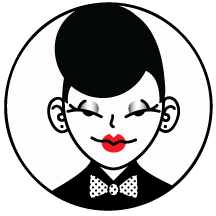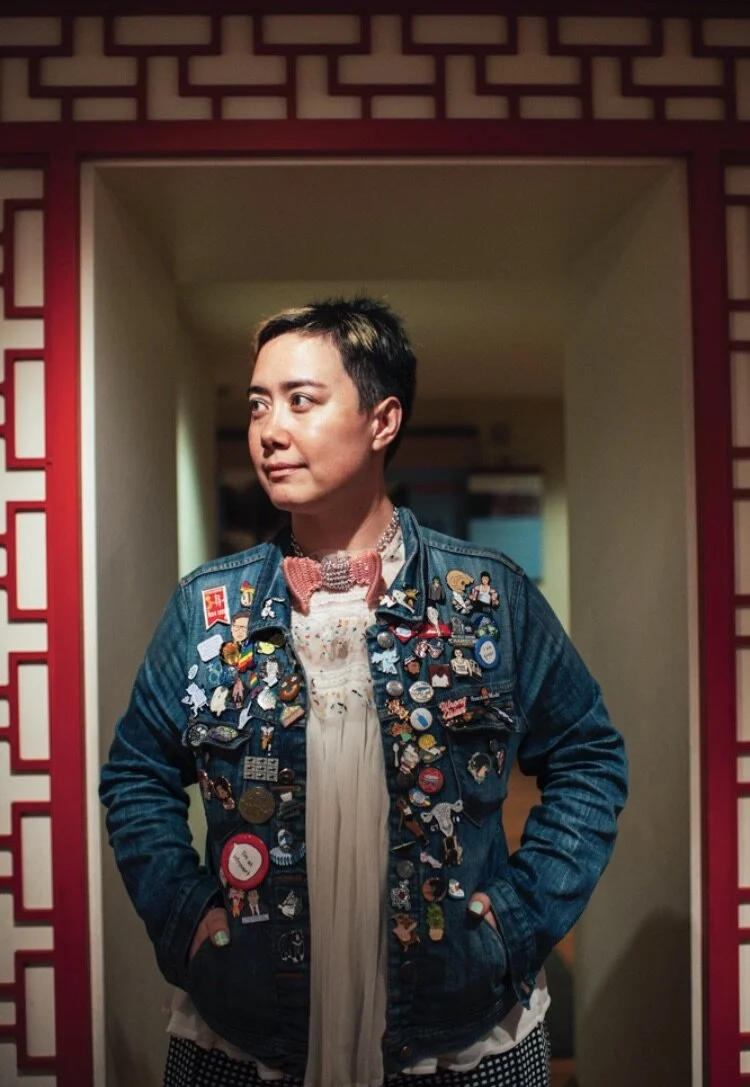letter from the editor
addie tsai
A queer, non-binary Asian person with short dark hair and blond tips on the bangs and the sides in the front stands in front of a doorway looking to the front left. The wall behind them has a red geometric pattern. They wear a jean jacket covered in enamel pins an buttons, a pink chain mail bow tie with a metallic center, a white blouse with confetti designs on the top and black and white checkered pants. Their hands are in their pockets.
It is a political act to take back a body that has been judged, shamed, objectified, harmed, and projected onto in countless ways and to reclaim it as a site of potentiality, aesthetic power, and joy.
Let me tell you a story, a story of beginnings.
I witnessed and heard stories that I would never experience outside of my own observation. Stories of adults who, as children, began to come into their own style, and their parents, partly out of exhaustion, and partly out of being charmed into it, would acquiesce to Sunday brunch with children in all manners of dress and sartorial combinations: feather boas and rainboots, tutus and baby fedoras, neckties and skirts.
I know not all of us were that lucky. But, some. Some of us grew up, found our people, took them home, and opened up old photo albums, and pointed, and said, see, right there. You can see it. You can see the body that I would grow into.
I was not one of the lucky ones. I grew up under the constant but stern hand of an Asian immigrant father, and as an identical twin. Our outfits were, for the most part, decided for us, day in and day out, long after it was legal to drive, and on some occasions, even after we had left home. There is a photo here, or there, like the one of me sitting at my desk in a vest. Or another of me standing on a cliff somewhere, with a flannel wrapped around my waist. But, those are from later years, as a teenager. Everything else was prescribed, and appropriate.
There were hints of who I was to become. I got punished for playing with my father’s briefcase as a child. My mother taught me how to tie her silk scarves around my neck as a makeshift necktie, something I would do for hours and hours. But, for most of my young years, I was seen as one thing, and it was not the one thing that I would now use to define myself.
As I began to grow into my own understanding of my body, of my queerness, of the liminal space I occupy between genders, I began to wonder, to hope: are there others out there like me? And slowly, ever so slowly, I began to find more of us. It became clear to me, perhaps almost two decades ago, that there needed to be a space for us.
But, I was what they called a late-bloomer, both in terms of my recognizing my non-binary-ness as well as my queerness. How could I be the one to curate such a space? And so, I waited. I kept my eyes open, my ears to the ground. I regularly searched for spaces that showcased the writing and artists of people from all parts of the LGBTQIA+ umbrella on fashion. I found exciting spaces that addressed one style or presentation, but none that represented all of us.
I cite as the first step forward in doing this thing I didn’t think I was “expert” enough at when I spoke to my dear friend, Filipinx non-binary trans writer and disability activist, Kay Ulanday Barrett, on the second floor patio of a hotel during the AWP Conference in early 2017 about the beginning of this idea I had to make a magazine that highlighted queer fashion. We talked through some ideas; I took them out for dim sum. And still, I waited.
Two years later, I was asked by Sarah Clark, a disabled two-spirit writer and the Editor in Chief at Anomaly, where I serve as co-Fiction Editor, but then was Assistant Fiction Editor, whether I had any ideas for curating folios with Anomaly. I decided this was the perfect forum to test out the waters of this idea. It was called Queering in Plain Sight: a folio of queer fashion. I’d like to share some of what I wrote to introduce and frame the marvelous works of that early experiment, which launched in December of 2019, which I wrote, in the middle of the grief of divorcing my only love and embracing the debut of my first book, sitting in a friend’s apartment in Astoria, a friend who I met while dancing tango and who had seen me go through so many of my own evolutions through gender expressions and expressions of queerness—femme to masc to everything in between. Thinking back on it now, what more perfect moment in time and selfhood to write such a piece, as it is in between the joy and the grief that we queers find—and have always found—ourselves. It is in the dressing that we can bring a lightness to our lives, and to one another:
For the queer community, we code ourselves with our bodies when it has been dangerous to identify ourselves with words, and we code ourselves with our bodies in order to join a community that may exist as the only family structure that makes us feel safe. Until recently, we could find only a handful of models in popular culture to inform our own aesthetic choices, and so the very styles that we don operate as a patchwork quilt, collaged together with vintage and thrift store finds, sometimes high end pieces (perhaps on discount), our sister or mother’s lipstick, and our father’s neckties. All the mismatched bric-a-brac that makes up a person’s aesthetic where it is not easily found.
Curating and publishing that folio was an incredibly exhilarating and life-affirming moment in this journey towards the pages you have before you. But most importantly, it confirmed two things for me, which led me to create just femme & dandy: first, that there was a need for a space like this one, to form community around LGBTQIA+ fashion. And second, that I had the permission and the ability to spearhead such a moment.
The pandemic, as you’ll see from our tender, thoughtful, extraordinary contributors T.J. Tallie & Mark Kurai in their excerpts from their pandemic fashion photographic project titled Queerantine, opened up opportunities for many of us to look more deeply at how we engage with others, and with ourselves, and perhaps unexpectedly, pushed us to explore the boundaries of what we wear and what we have always longed to wear, but been afraid to embody. I, too, began my own pandemic photographic project this February—perhaps unsurprisingly exactly a year after my pandemic divorce became official—by “remaking” an image of an artist of color every day, and sharing it on Instagram (@addiewearshistory) along with an extended caption of why that artist has impacted my own practice of way of living and thinking in the world as a queer, non-binary person of color.
But, what the pandemic offered me, and offered many of us, was a chance to push ourselves in new ways, and to take on projects or initiatives we were too timid to take on before.
Perhaps because I entered this earth as a pair, I work best in collaboration with others. I work best in the dialogic, the exchange of ideas, and I always seek out those who will challenge me, and who will see things that I don’t have the lived experience to see as readily. That is why I knew, without question, that I wanted Sarah Sheppeck to herald this endeavor with me. We came to know of each other when she reviewed my first book, just a month after Queering in Plain Sight would be introduced to the public. Sarah is a force to be reckoned with, a Black queer femmegoth with the voice of an angel and a sharp wit, especially when it comes to her iconic Dad jokes. You can credit her for most of the pun-worthy titles of our sections. As we became closer friends during the beginning of the pandemic, and I asked, if, just maybe, she might want to run this thing with me, she didn’t hesitate. I can’t imagine partnering this enterprise with anyone else.
I studied fashion magazines and thought deeply about sections for the magazine that would offer aspects of LGBTQIA+ fashion that I saw energy around in the conversations and ensembles I saw in my friends, community, and from passersby on the street. From there, Sarah and I refined them to the following: the glowup for skincare & cosmetics, the mane attraction for hair (with afrodisiac, a dedicated column focusing on Black hair), sole mates for shoes, no scrubs for streetwear, sew what for DIY and thrift, triple thread(s) for bespoke and couture, and cancel & gretel for ethics & inclusion. I can’t say enough about our incredible team of editors, some old friends, some new acquaintances, some long admired, from a range of backgrounds and identities: SJ Sindu, Jen St. Jude, Denne Michele Norris, Jo Davis-McElligatt, Octavia Saenz, Kirin Khan, and Sky Cubacub. I want to especially thank Sky Cubacub for their labor with ensuring that our magazine is as accessible as possible.
just femme & dandy volume 01 traverses across over 100 pages and twenty-five contributions to provide just an offering of how glorious and powerful we are, and how what we say with how we accessorize and clothe ourselves is a process of reclamation, of celebration, and, most of all, what we need now more than ever, joy. I hope, more than anything else, this work, however it may find you, brings you joy, and makes you feel empowered in your own complex, beautiful, marvelous selves, within and beyond your bodies. That is what it has done for me, and then some.
Addie Tsai
Founding Editor
Co-Editor in Chief
just femme & dandy
June 2021


